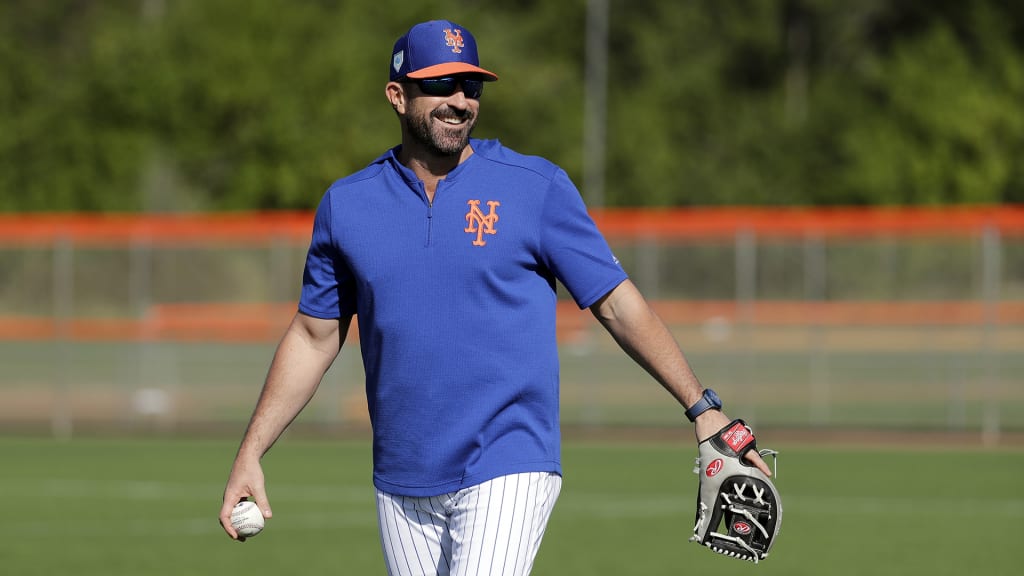
PORT ST. LUCIE, Fla. -- Early this spring, the Mets turned one of their back fields into what looked like a shuffleboard court, painting point values on the grass to reward successful bunts. A couple weeks later, during a Major League intrasquad game, the team cycled players through a bunting station in a screened-off area behind home plate. After the Mets’ first Grapefruit League game, manager Mickey Callaway walked into the press conference room and, unprompted, began gushing about Robinson Cano’s ground-ball single to beat a shift.
These are not throwaway anecdotes so much as evidence of an organizational trend. From the Dominican Summer League on up to the Majors, the Mets’ new front office is placing increased emphasis on bunting and situational hitting. When teams employ defensive overshifts on their Minor Leaguers, the Mets -- for the first time -- are encouraging their players to bunt to beat them.
“Game situations will dictate it,” farm director Jared Banner said. “I’m not going to say it’s a blanket rule, but we want all our guys to have the ability and feel comfortable. We just want our guys to be versatile, to have the ability, so that they won’t get shifted against as much.”
This is a skill set the Mets, over the past decade, largely de-emphasized -- at times to their detriment. In the 10th inning of a game against the Dodgers last June, Callaway absorbed criticism for not asking Dominic Smith to bunt with the go-ahead run on first base, no outs and a defensive overshift in front of him. A bunt down the third-base line would have given the Mets a near hammerlock on the game. Instead, Smith struck out and the Mets lost in 11 innings.
Callaway said he did not ask Smith to bunt because he had “never bunted in his professional career.” (At the time, he had one successful sacrifice in more than 2,000 plate appearances.) A Daily News headline that week blared: “Poor player development is at the heart of Mets’ issues.”
“That was just never in my game,” Smith said. “I wanted to just hit. And teams never shifted me, either. Last year was the first year they shifted me. I didn’t take advantage of it. I didn’t lay down any bunts. I didn’t really try to go the other way too much. I was so focused on power, hitting home runs.”
Consider the emphasis changed. Recently, Mets coaches sent Smith to a back field for a private session; he dropped down bunt after bunt in front of a high-speed camera, which allowed officials to evaluate his hand placement, form and other details. Smith has also bunted several times in Grapefruit League games. It hasn’t always worked -- a recent try resulted in a groundout to the pitcher -- but the Mets believe only a few successes will be necessary to make teams think twice against shifting. They want the threat to be omnipresent. This winter, the Mets set up bunting stations at their Dominican academy. Minor League staffers have created bunting competitions with rewards for the winners, while Callaway has publicly lauded big leaguers who have bunted or gone the other way in games.
“I have a philosophy that the way to beat analytics is to go against analytics,” Callaway said. “If certain teams are going to value analytics to a certain degree, then we’re going to do whatever we can to counteract that.”
That includes an ability and a willingness to hit to the opposite field. Cano, an offseason trade acquisition, will undoubtedly help in that area; over the past four years, according to Statcast data, 61.2 percent of Cano’s hits have gone to left and left-center. New signing Jed Lowrie also has more hits to the opposite field than the pull side, as does Jeff McNeil, a second-year player who will be in the lineup more often this season. To augment that bunch, the Mets hired a hitting coach, Chili Davis, who values contact hitting over home-run power.
Davis and others have worked with left-handers like Smith and Conforto, who ranked among MLB’s most-shifted players last season when facing right-handed pitchers.
“I know it’s little things, and it’s like, 'Well, we should be doing that,'” general manager Brodie Van Wagenen said. “The reality is, we are. We don’t want to find a situation at the big league level that we haven’t practiced time and time and time again.”


